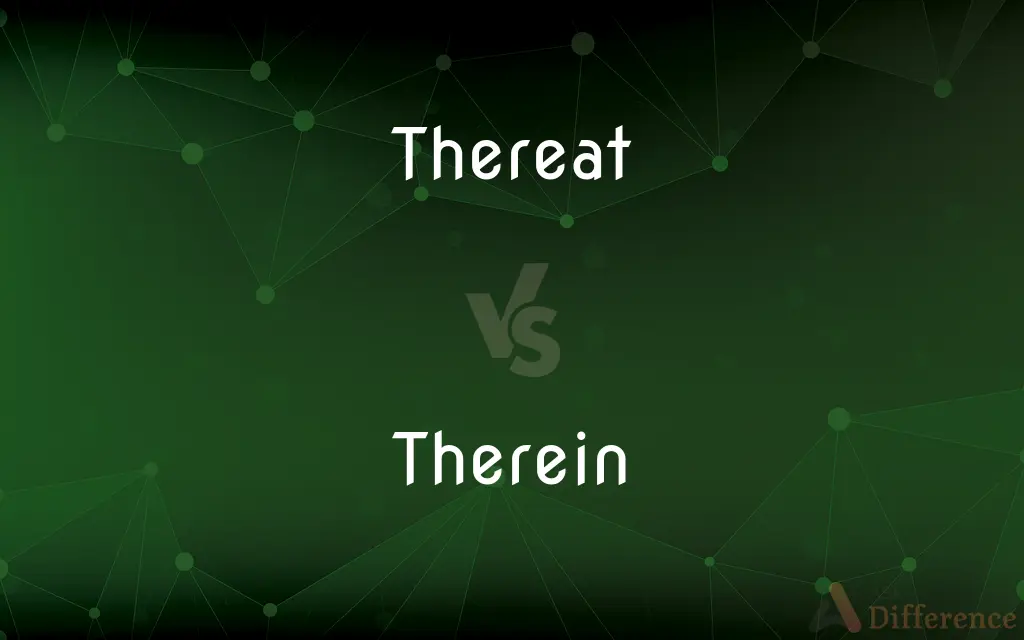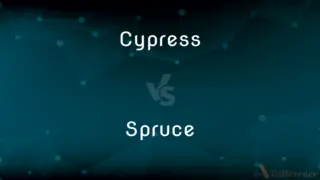Thereat vs. Therein — What's the Difference?
Edited by Tayyaba Rehman — By Urooj Arif — Updated on March 30, 2024
Thereat refers to being at that place or situation, often implying a reaction, while therein suggests being within or inside that context or document.

Difference Between Thereat and Therein
Table of Contents
ADVERTISEMENT
Key Differences
Thereat specifically points to a location or situation, usually implying some sort of reaction or consequence related to that place or event. For instance, when a surprising announcement is made, one might say they were amazed thereat, emphasizing the reaction to the occurrence at that specific spot or moment. On the other hand, therein is used to indicate being within or inside something, often a document, place, or situation. It highlights the content or elements contained within a defined boundary, such as when one says important details are found therein, referring to a document or text.
Thereat often conveys a direct connection to a specific location or scenario, suggesting an immediate or direct response to something that occurs at that place or time. It's as if the speaker is pointing to a spot on a map or a moment in a story, indicating something significant or noteworthy. Whereas, therein emphasizes what lies inside or forms part of something, such as details within a report or qualities inherent in a concept, making it a key word for specifying content or components.
While thereat can suggest a physical or metaphorical stance in relation to an external event or location, implying observance or participation, therein often points to the contents or inherent aspects of something, emphasizing inclusion or embedment. This distinction is crucial in legal, literary, or formal contexts where the precise nature of reference to location or content matters significantly.
Thereat is particularly useful when indicating a reaction to or the significance of a specific event or location. It has a flavor of antiquity or formality, often appearing in legal documents, historical texts, or literary works to mark a specific point of interest or activity. In contrast, therein is commonly used to refer to the contents of a document, theory, or situation, maintaining a sense of formality and specificity regarding the internal aspects or included elements.
The use of thereat vs. therein thus not only differentiates based on the 'at a place' versus 'within something' distinction but also reflects the speaker or writer's intention to focus either on a reaction to an external situation (thereat) or the content and elements that are part of an internal structure (therein).
ADVERTISEMENT
Comparison Chart
Definition
Refers to being at that place or situation, often implying a reaction.
Suggests being within or inside that context or document.
Connotation
Reaction or consequence related to a specific location or event.
Content or elements contained within a boundary.
Usage Context
Often used in legal, historical, or literary texts.
Commonly found in formal, legal, and academic writing.
Focus
External event or location and the reaction to it.
Internal contents or aspects of something.
Typical Association
Direct connection to a location or scenario.
Emphasis on the contents or inherent aspects.
Compare with Definitions
Thereat
At that place or event.
She arrived at the scene, and thereat, she found the lost puppy.
Therein
In that place, document, or respect.
The contract details the obligations of both parties therein.
Thereat
At the occurrence of that event.
The bell rang, and thereat, everyone headed to the assembly hall.
Therein
Within the limits, bounds, or content of something.
Therein lies the problem with the current policy.
Thereat
At that point in a discussion or narrative.
Thereat, the speaker paused for dramatic effect.
Therein
Within that context or situation.
The secret to the recipe lies therein.
Thereat
Concerning that matter.
Thereat, the committee decided to adjourn the meeting.
Therein
Pertaining to the content or substance of something.
The beauty of the poem is not just in its words, but in the emotions captured therein.
Thereat
In that respect or relation.
The law was explained, and thereat, the confusion was cleared.
Therein
In that case or particular.
If you decide to proceed, therein you'll find the challenge.
Thereat
At that place; there.
Therein
In that place, time, or thing.
Thereat
At that event; on account of that.
Therein
In that circumstance or respect.
Thereat
There; at that place.
Therein
(pronominal) in that; in that place; in him/her/it.
Thereat
At that event.
Therein
In that or this place, time, or thing; in that particular or respect.
He pricketh through a fair forest,Therein is many a wild beast.
Bring forth abundantly in the earth, and multiply therein.
Therein our letters do not well agree.
Thereat
At that place; there.
Wide is the gate, and broad is the way, that leadeth to destruction, and many there be which go in thereat.
Therein
(formal) in or into that thing or place;
They can read therein what our plans are
Thereat
At that occurrence or event; on that account.
Every error is a stain to the beauty of nature; for which cause it blusheth thereat.
Common Curiosities
Can thereat imply emotion?
Yes, thereat often implies a reaction or emotion in response to a specific situation.
How formal are these terms?
Both are considered formal and are more common in written English, especially in legal or academic contexts.
How is therein used?
Therein is used to indicate being inside or within something, like a document or situation.
Are there modern synonyms for these terms?
Modern equivalents might be "at that place" for thereat and "within it" for therein, but they lack the formal tone.
What does thereat mean?
It refers to being at a specific place or event, often indicating a reaction.
Can I use thereat at the beginning of a sentence?
Yes, but it's more common to see it following a clause or phrase that sets up the reference point.
Does therein suggest inclusion?
Yes, it implies that something is contained or included within a defined boundary or context.
Is therein always about physical locations?
No, therein often refers to being within documents, theories, or discussions, not just physical places.
Is there a preference for using these in legal documents?
Yes, both are frequently used in legal texts, but their use depends on the context—thereat for situations or locations, therein for contents or internal aspects.
What makes therein special in legal language?
Its ability to specify and clarify the exact contents or scope within legal documents makes it valuable.
Can thereat be used in everyday conversation?
It's less common in casual speech due to its formal tone.
Can thereat and therein be used interchangeably?
No, due to their different focuses—thereat on location or reaction, and therein on content or inclusion.
Why might someone choose to use thereat today?
For its precision and formal tone in describing reactions to or the significance of specific places or moments.
What's the difference in application between thereat and therein?
Thereat is used for reactions or references to specific locations or events, while therein refers to the contents within something.
How do thereat and therein enhance writing?
They provide precision and a formal tone, especially useful in legal, academic, and literary contexts.
Share Your Discovery

Previous Comparison
Cypress vs. Spruce
Next Comparison
Masstige vs. PrestigeAuthor Spotlight
Written by
Urooj ArifUrooj is a skilled content writer at Ask Difference, known for her exceptional ability to simplify complex topics into engaging and informative content. With a passion for research and a flair for clear, concise writing, she consistently delivers articles that resonate with our diverse audience.
Edited by
Tayyaba RehmanTayyaba Rehman is a distinguished writer, currently serving as a primary contributor to askdifference.com. As a researcher in semantics and etymology, Tayyaba's passion for the complexity of languages and their distinctions has found a perfect home on the platform. Tayyaba delves into the intricacies of language, distinguishing between commonly confused words and phrases, thereby providing clarity for readers worldwide.













































